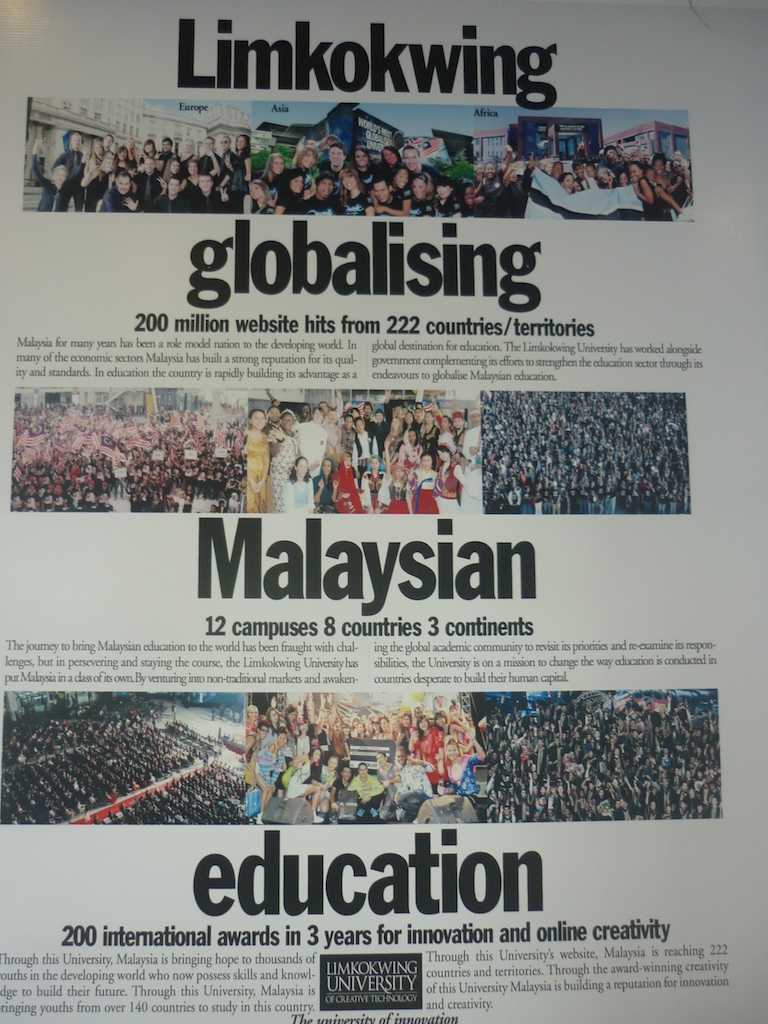Malaysia has developed a market for private higher education in the past few decades. Education turned into a commercial product, which is advertised by the universities’ marketing departments and offered internationally. On a hot and hazy afternoon, Sandra and I drove to Cyberjaya, a satellite town in the Klang Valley in the periphery of Kuala Lumpur, planned as the Malaysian Silicon Valley. There is the main campus of Limkokwing University, a pioneering institution that sticks out with its rather aggressive marketing strategy. As visitors, we got the impression that the whole idea behind this university is a big image campaign. The university opened up branch campuses around the world, not only in Southeast Asia but also in Africa and the Middle East.
Limkokwing’s student population is overwhelmingly international. Young people not only from Brazil or Russia but also from Sudan, Nigeria or Botswana mingle here to study fashion, graphic design and business administration. Thus, they are not like the typical international students who come from the global south to study engineering or computer sciences in Malaysia (to get an impression of Limkokwing University: https://www.youtube.com/watch?v=7S_idIa-BqI ).
A Malaysian degree, especially at a private university, has its price. A week later, we drove to the Malaysian Campus of the University of Nottingham (UNMC), which is equally far off as Limkokwing. Here, prices start at 26.000 Ringgit Malaysia (RM) per year for a bachelor degree in English Language and Literature and go up to 70.000 RM (equals 15,500 Euro) for a master in pharmacy . The international student population comprises 40 per cent of the university’s whole student body. The number of local students has only recently risen, since the government started to grant scholarships to Malay Malaysians. Non-Malay students are according to my Sudanese respondents, two female students of UNMC, mostly of Chinese Malaysian background and come self-financed.
In 2011, there were around 93.000 international students studying in Malaysia, but the country aims to rise this number to 200.000 in 2020 . Despite the high tuition fees, approximately 72 per cent of these international students are in private universities. In 2012, Malaysia’s Department of Immigration reported that a total of 79.000 Africans entered the country. The same department issued around 25.000 student visas for African students (student visas are valid for one year). Most of my respondents came from middle-class families and in the case of the Sudanese students from wealthier families, who are sometimes expatriates working in Saudi Arabia, Kuwait or Oman. Some Nigerian students take loans to study abroad. None of my respondents received government scholarships. Especially the Malaysian private universities cooperate with recruiting agents, who are paid for recruiting new students. The agents are often former students, who returned to their home country; or alumni from other universities.
African students and migrants have been victims of stereotyping in the Malaysian media lately. Many stories revolve around criminal activities and perpetuate the same negative images that were attached to Indonesian or Bangladeshi migrant workers in the past, who were portrayed as a threat to the security of Malaysian society. In August 2013, the Malaymailonline reported that a condominium in the Klang Valley decided to ban African tenants from the apartment building. One reason that was named was that the value of the property would deteriorate once Africans move in. Thus, it was decided at the general assembly of the owners that all African tenants had to move out within three months. The news coverage was followed by a huge outcry by alternative news magazines and bloggers on the internet, criticizing the issue of banning Africans and wondering about whom the category would include. A Nigerian blogger, working in Kuala Lumpur’s creative industry, wrote : “The bigger question is, how do you define “African” in that context? I mean, does the ban apply to white South Africans? What about Arab men from Egypt? Or a Mauritian Indian. A Kenyan Chinese. If we’re being completely honest, this ban, it’s just a ban on black people. Period.” It was later on reported that the owners’ assembly of the condominium withdrew its original plan due to the strong public reaction.
This ambivalence between the economic value of African students paying high tuition fees at Malaysian universities and the public fear of Africans stirred by the local media will be worth observing in the coming months.






